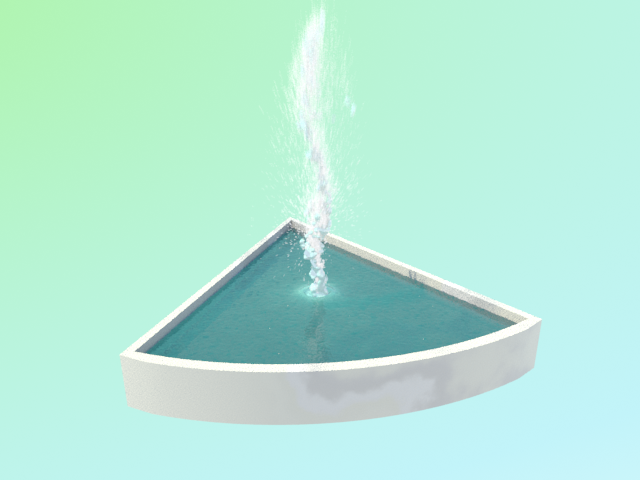
Can I create more than one fluid simulation in the same scene?
- You can add as many simulations as you want to a scene; however, they will not interact with each other. When you need interactivity, you must add all emitters and related objects to the same simulation.
How can I speed up my previews?
- The default voxel size default is 0.5, which is generally used for a higher resolution final output. The higher the value, the longer the simulation will take. Values of greater than 2.5 are often good enough to get a general idea of how the simulation is developing while offering considerately faster performance. Go to Simulation View > Simulation Parameters > Solver Properties > Base Voxel Size to adjust the setting.
Can I add a modifier to a fluids object?
- Fluid objects are only compatible with modifiers if a cache mesh has first been generated. The use of modifiers is nevertheless not recommended as the effects are unpredictable and can seriously degrade system performance. Modifiers will also not affect the liquid when rendering using Arnold Surfaces or Arnold Points.
What controls the resolution of the simulation and how do I work with it?
- Voxel size is the main control for the resolution of a simulation. Larger voxel sizes provide low detail and are good for tests and previews as you adjust settings, while smaller sizes provide finer detail and better accuracy for the final output.
The main setting for voxel size is Base Voxel Size under Solver Parameters > Simulation Parameters. This determines the voxel size used for the fluid simulation itself, and is also the base size used to voxelize meshes including emitters, colliders, and other objects. Note that when you change the Base Voxel Size, you may also need to adjust the time adaptivity settings.
How does voxel scale affect resolution?
- Every mesh object such as an emitter or collider has a Voxel Scale setting which affects how the associated meshes are initially voxelized. In addition, you can override the global voxel scale settings for individual emitters, colliders, guide meshes, and guide emitters, using smaller values to get more detail in a simulation only where needed.
If you set Voxel Scale of a collider to a value less than 1.0 for more detail on a specific mesh, some of that detail may be lost when the colliders are combined at a larger voxel size. If you require high detail on specific meshes, you should use a global Voxel Scale less than 1.0, and a Voxel Scale greater than 1.0 in the mesh properties of the other meshes.
Why are particles leaking through my collider?
- The most common reason is that the voxel size is too large, and the sampling of the particles too infrequent. To fix this, try reducing the base voxel size and adjusting the time and transport step settings in Simulation View > Solver Parameters > Simulation Parameters.
Why won't a volume fill up with liquid?
- When simulating more complex liquids you can exceed the number of particles in your simulation. You can fix this by opening the Simulation View > Solver Parameters > Simulation Parameters > Solver Properties and clear the Delete Exceeding Particles checkbox.
Why don't I see anything when simulating?
- The base voxel size may be set too large. To confirm this you can check the cache files: if they are each 22kb, no simulation data is being stored. Try decreasing the value in Simulation View > Simulation Parameters > Solver Properties > Base Voxel Size.
Fluids may also not emit when using Solid (Robust) mode or influencers along with a Base Voxel Size of less than 0.5.
Why is my fluid behaving strangely when I set my density really low?
- This can happen when Surface Tension is enabled with low densities. Try disabling the option in the Liquid Parameters panel.
How can I save a current-release Max file as a previous version without losing my fluid simulation?
- To avoid compatibility issues, fluid simulations are automatically removed whenever saving to previous versions. To override this with Max 2017, include the following line in the 3dsmax.ini file under the [Plugins] section: FluidSaveAs2017=1.
Why can't I link an Arrow helper to my emitter?
- Although you can link Arrow helpers directly to custom emitters you have created, they cannot be linked to the standard Sphere, Box, or Plane emitters, which are world-space objects and part of the simulation itself. If you wish to link an Arrow helper to a standard emitter, use the following procedure:
- Create a Liquid object.
- From the Helpers panel, create a Dummy helper.
- From the Helpers panel, create an Arrow helper.
- For the liquid solver, turn on Additional Velocity and pick the Arrow helper.
- Link the Liquid object to the Dummy helper.
- Link the Arrow helper to the Dummy helper.
- Animate the Dummy as desired.
How can I speed up or slow down the overall effect of my fluid simulation?
- On the Solver Parameters panel under Simulation Parameters, go to the Simulation Parameters rollout and adjust the Time Scale in the Transport Steps group.
